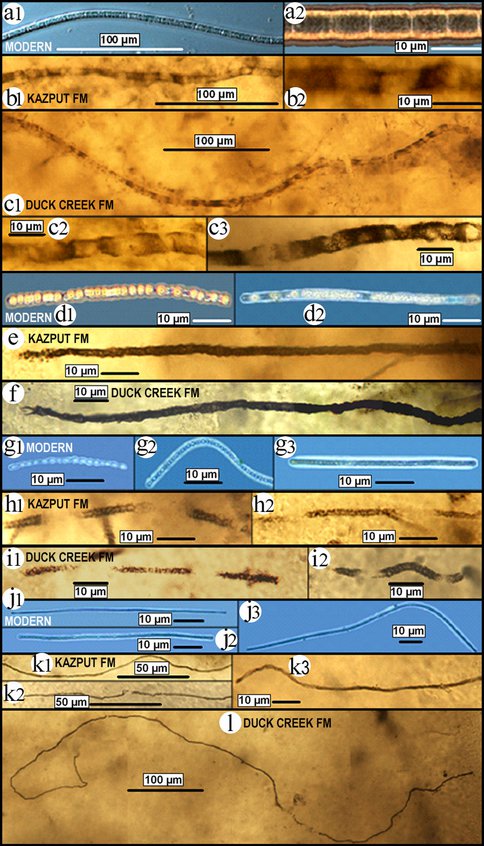2013 Annual Science Report
 University of Wisconsin
Reporting | SEP 2012 – AUG 2013
University of Wisconsin
Reporting | SEP 2012 – AUG 2013
Project 3D: Microfossil Insights Into Proterozoic Microbial Ecology
Project Summary
In a study of the chert-permineralized 1.8 Ga Duck Creek Dolomite, and underlying units, Western Australia, Schopf found that in sequences of 2.3 to 1.8 Ga age that indicate little environmental change, there has been no evolution of the form, function, or metabolic requirements of its biotic components. In a second study of sulfur-cycling bacteria from the 775 Ma chert-permineralized Bambui Group of Brazil, Schopf showed that pyritized microbes of this age were anaerobic sulfur-cyclers. This work, in addition to previous studies, forms the basis for ongoing studies of the biotic response to the Great Oxidation Event.
Project Progress
Understanding the diversity of microbial ecology of ancient terrestrial life is an important component to understanding how Earth’s biosphere evolved. One approach is to look at the distribution of microfossils. In one study, we compared the morphology and distribution of microfossils between 2.3 and 1.8 Ga, through comparison of samples from the 2300-Ma-old Kazput Formation (Turee Creek Group) and ~1800-Ma-old Duck Creek Formation, both from Western Australia. Specifically, work focused on microfossils that reflect ancient sulfuretums. The lack of clear evolution over this time period provides, evidently the first time, affirmation of the null hypothesis required of Darwinian evolution: if there is no change in the physical-biological environment of a well adapted ecosystem there will be no evolution of the form, function or metabolic requirements of its biotic components. Strikingly, comparison to modern sulfuretums off the west coast of Chile show little significant difference (see Figure).
In a second study, a chert-permineralized microbial community from the ~775-Ma-old Bambui Group of Brazil, demonstrates, evidently for the first time, that pyritized microbes of this (and no doubt many other Precambrian microbiotas, previously regarded as Bacteria Incertae Sedis) are anaerobic sulfur-cyclers. These studies are part of an effort to document the biotic response to the mid-Precambrian (2.4- to 2.2-Ga) Great Oxidation Event (GOE), based on four lines of evidence; (1) the anaerobic to aerobic transition of metabolic and biosynthetic pathways; (2) rRNA phylogeny-correlated fossil evidence of O2-protection in immediately post-GOE-preserved cyanobacteria; (3) the earliest fossil occurrences of obligately aerobic eukaryotes; and (4) recent discoveries of mid-Precambrian anaerobic microbial sulfuretums dependent on the GOE-promoted increase of required nutrients.
Publications
- Schopf, J.W., Kudryavtsev, A.B., Walter, M.R., Van Kranendonk, M.J., Williford, K., Kozdon, R., Valley, J.W., Gallardo, V.A., Espinoza, C. & Flannery, D.T. (Submitted). A fossil sulfuretum from the 1.8 Ga Duck Creek Formation: microbial evolutionary stasis confirms evolutionary theory. PNAS.
-
PROJECT INVESTIGATORS:
-
PROJECT MEMBERS:
James Schopf
Project Investigator
Reinhard Kozdon
Co-Investigator
Anatoliy Kudryavtsev
Co-Investigator
Kenneth Williford
Co-Investigator
Carola Espinoza
Collaborator
David Flannery
Collaborator
Victor Gallardo
Collaborator
John Valley
Collaborator
Martin Van Kranendonk
Collaborator
Malcolm Walter
Collaborator
-
RELATED OBJECTIVES:
Objective 4.1
Earth's early biosphere.
Objective 5.1
Environment-dependent, molecular evolution in microorganisms
Objective 5.2
Co-evolution of microbial communities
Objective 6.1
Effects of environmental changes on microbial ecosystems
Objective 7.2
Biosignatures to be sought in nearby planetary systems
